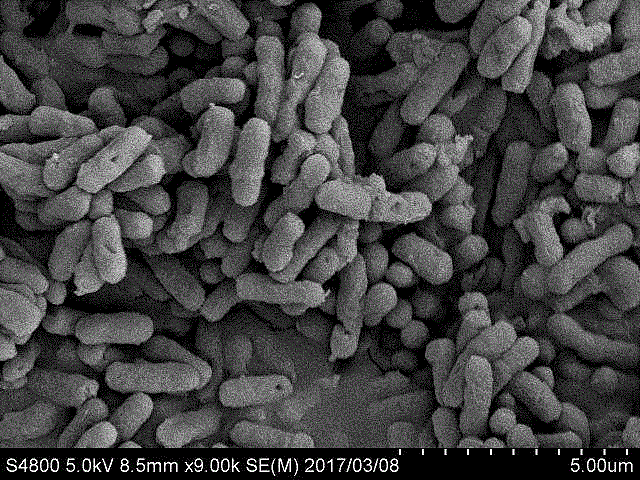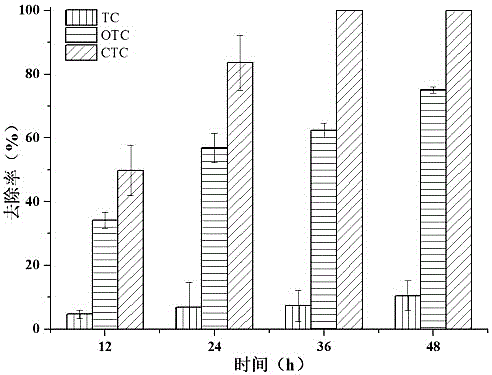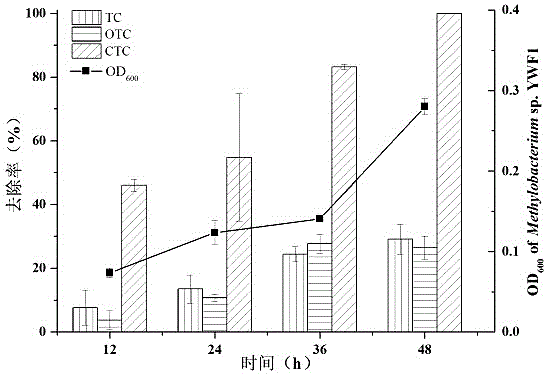Degrading bacterium for TC (tetracycline) antibiotics and application of degrading bacterium
A tetracycline and antibiotic technology, applied in bacteria, microorganisms, microorganisms, etc., can solve the problems of undiscovered degrading engineering bacteria and environmental damage
- Summary
- Abstract
- Description
- Claims
- Application Information
AI Technical Summary
Problems solved by technology
Method used
Image
Examples
Embodiment 1
[0022] Inoculate the suspension of degrading bacteria YWF1 pre-cultivated in sodium acetate as the carbon source into the liquid medium with 10 mg / L TC, OTC and CTC as the sole carbon source, and place it in a shaker at 37 °C to Culture at 150 rpm in the dark. Sampling was taken at regular intervals, and changes in the concentration of antibiotics were determined by high performance liquid chromatography. attached by figure 2 It can be seen that the removal effects of degrading bacteria YWF1 when using TC, OTC and CTC as the sole carbon source are as follows: Compared with the sterile control group, within 36 h, the removal efficiencies of degrading bacteria YWF1 on 10 mg / LCTC, OTC and TC were respectively are 99.00% ± 0.01%, 62.44% ± 2.19% and 7.37% ± 4.87%. The above results indicated that the degrading bacteria YWF1 could achieve good degradation in the presence of a single tetracycline antibiotic.
[0023] In the above experiment, the liquid medium with 10 mg / L TC, OTC...
Embodiment 2
[0025]Inoculate the suspension of degrading bacteria YWF1 pre-cultivated in sodium acetate as carbon source into liquid medium with TC, OTC and CTC as mixed carbon source (the total concentration of tetracycline antibiotics is 30 mg / L, pH is 7.0), and the It was cultured in a shaker at 37 °C at 150 rpm in the dark. Samples were taken regularly, and the concentration changes of the three antibiotics were determined by high-performance liquid chromatography, and the OD was measured by a UV spectrophotometer at the same time. 600 To study the growth of degrading bacteria YWF1 with mixed tetracycline antibiotics as the only substrate. attached by image 3 It can be seen that the degrading bacteria YWF1 can grow in the liquid medium in which the three tetracyclines co-exist, with the three tetracycline antibiotics as the mixed carbon source. The removal rates of CTC, OTC and TC within 36 hours of the degrading bacteria YWF1 in the mixed antibiotic treatment group were 83.18% ± 0....
PUM
 Login to View More
Login to View More Abstract
Description
Claims
Application Information
 Login to View More
Login to View More - R&D
- Intellectual Property
- Life Sciences
- Materials
- Tech Scout
- Unparalleled Data Quality
- Higher Quality Content
- 60% Fewer Hallucinations
Browse by: Latest US Patents, China's latest patents, Technical Efficacy Thesaurus, Application Domain, Technology Topic, Popular Technical Reports.
© 2025 PatSnap. All rights reserved.Legal|Privacy policy|Modern Slavery Act Transparency Statement|Sitemap|About US| Contact US: help@patsnap.com



